Our yard provides a lot of habitat for many creatures, but without habitat in the community beyond our yard, it’s only a small oasis — an important oasis, but not enough to preserve life on the planet.
To preserve biodiversity and leave our children and grandchildren the legacy of a living planet, we need to provide habitat in the community beyond our yard.
And these fragments need to be connected!
Patterns of land use
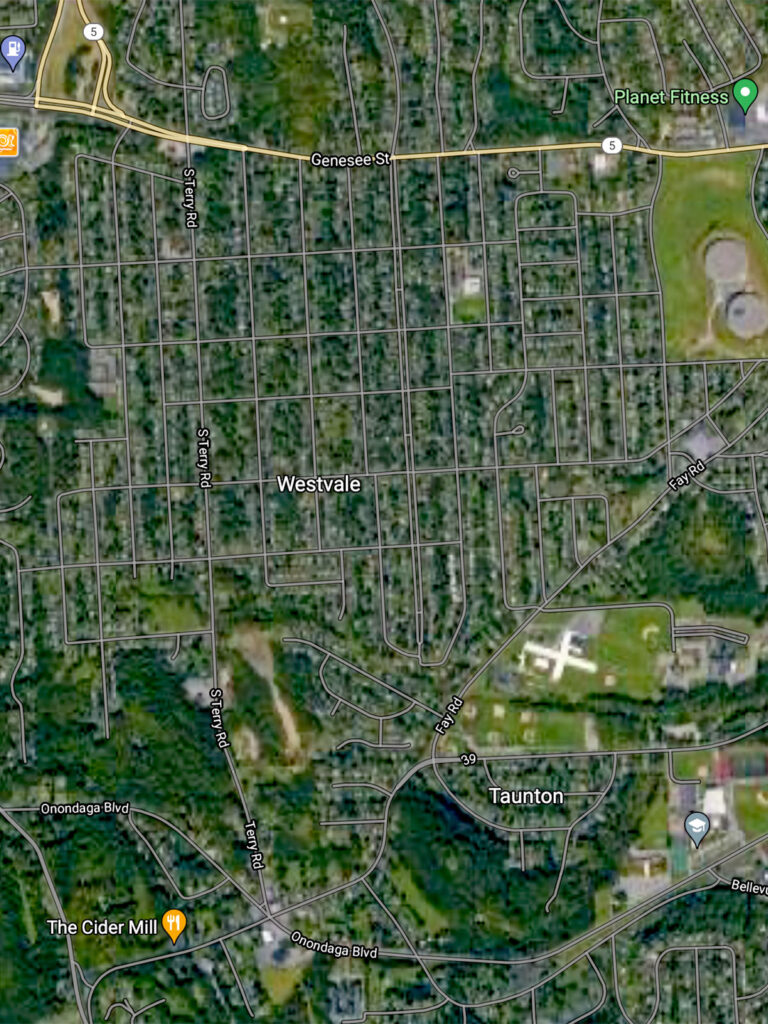
Though it’s too late for our neighborhood (which was developed in the 30s, 40s, and 50s), I can see the advantages of splitting land up differently, such as Ithaca Ecovillage did. They clustered the houses together instead of chopping the land up equally among the houses, so on the same amount of land they have much larger areas for growing food as well as for meadows and woodlands — something everyone in the whole village can enjoy.
No-mow areas
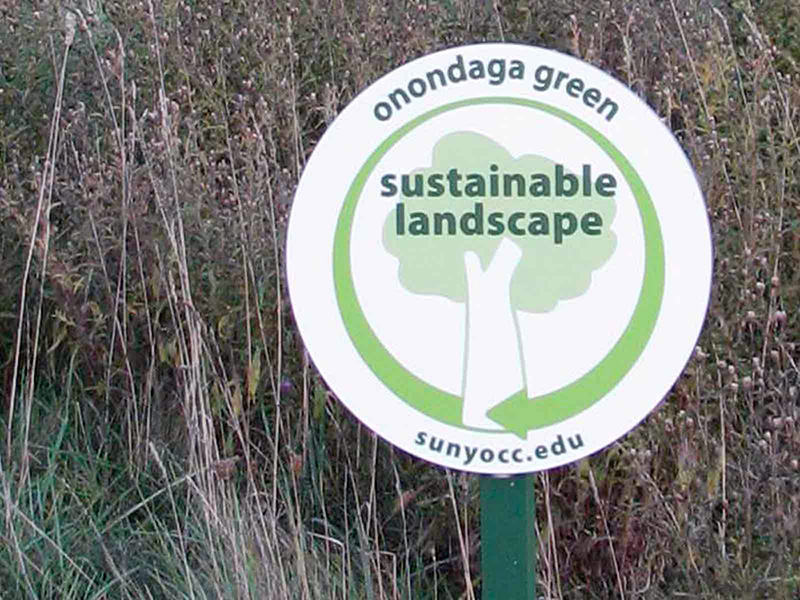
Our local community college is situated on a hillside near some natural areas, so why create vast maintenance-intensive lawns? The solution is to have meadows, but mow a curving strip near the road, so it shows that this is an intentional landscape. Signage helps, too.
Pollinator-friendly landscapes in the community
Pollinator conservation is an important issue, and because these creatures are so small and can benefit from small-scale efforts, it’s a particularly appropriate for community projects.
Cities and suburbs can provide habitat connectivity, an extremely important role for communities.
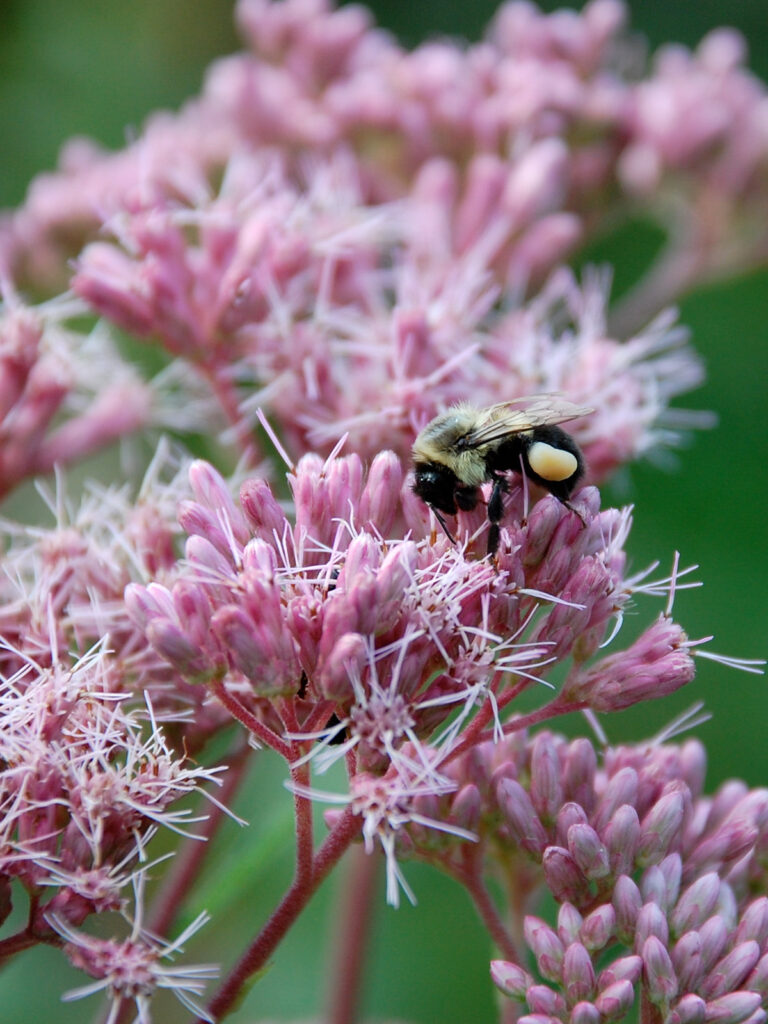
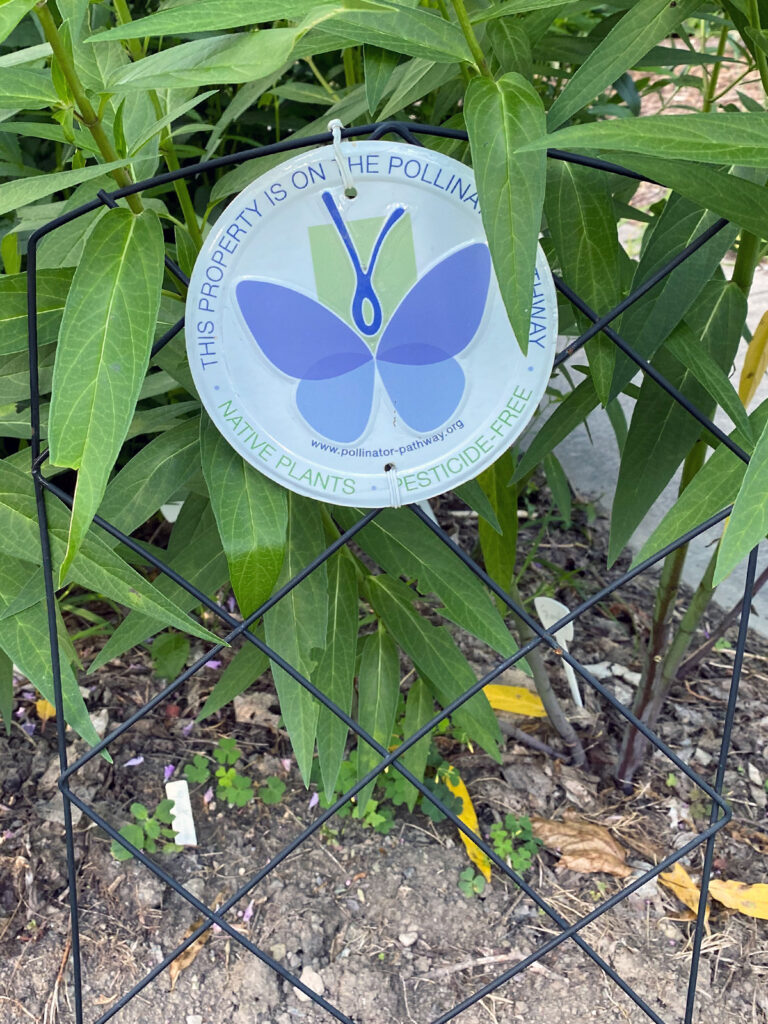
One attempt to create this connectivity is the Pollinator Pathways project. I added my hellstrip to the Pathway, but sadly, it doesn’t yet connect to anything else.
Educating the public about the importance of bees is important since many people still view bees as a problem rather than as the valuable (and enjoyable!) resource they are.
Merely decorative seasonal plantings
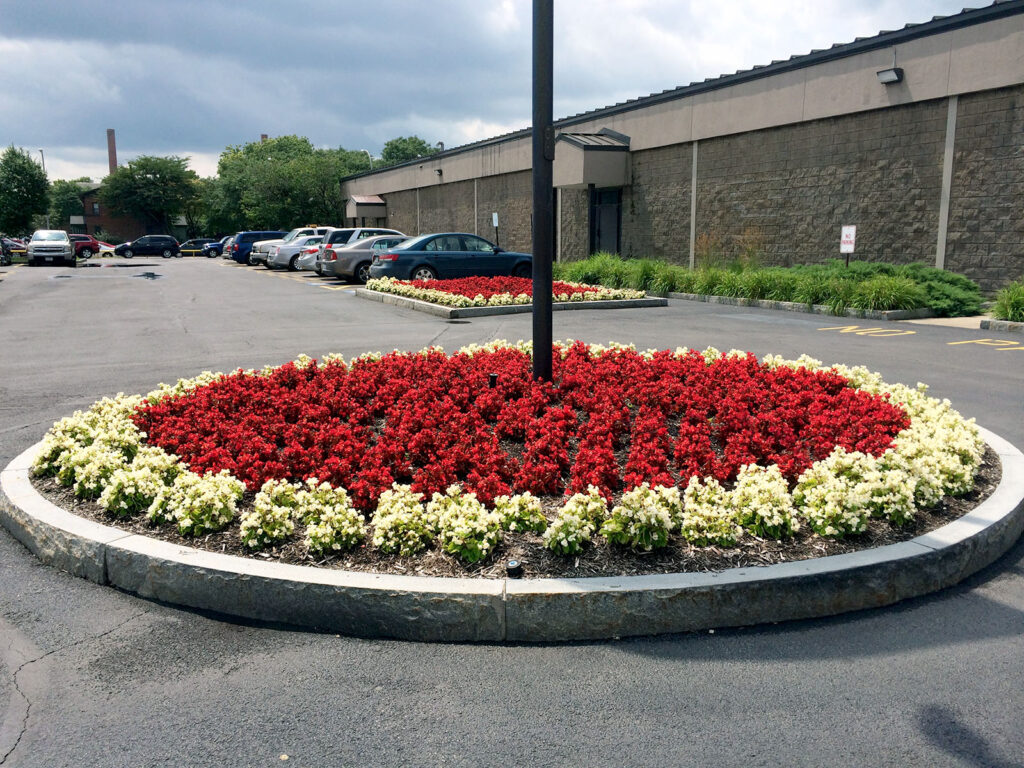
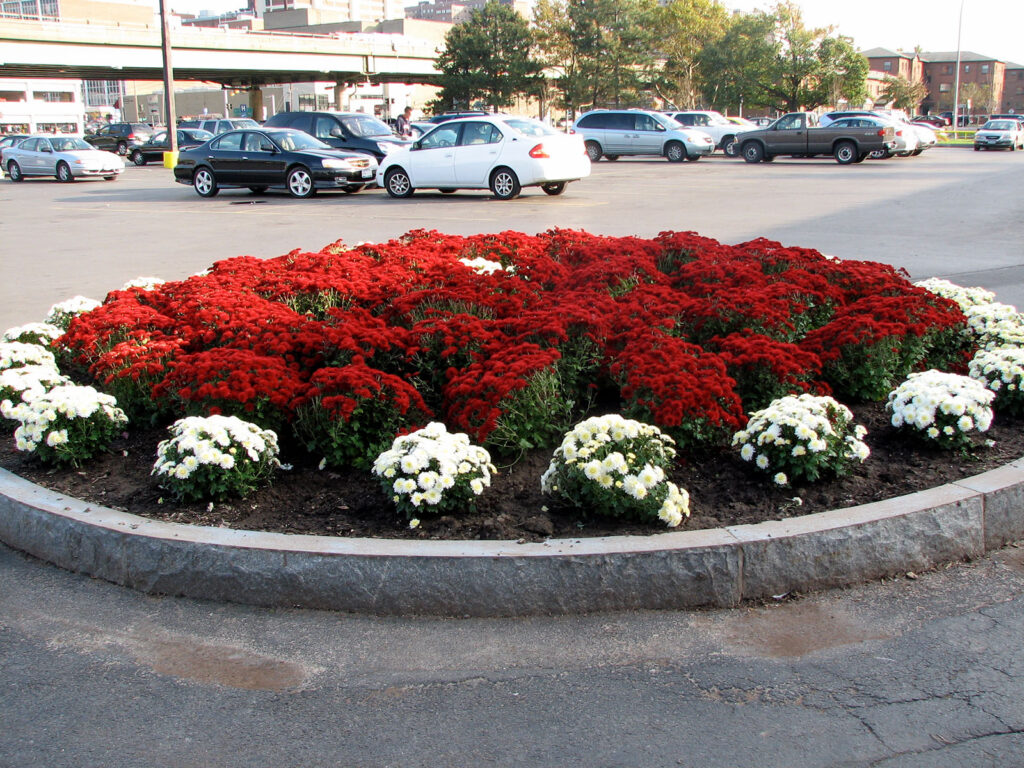
I happened to notice this planting downtown one year. In the spring and summer, it was red and white — non-native — begonias. In the fall, it was red and white — non-native — mums. While I was taking this fall photo, I noticed a monarch flying through this parking lot that was full of flowers, but which offered nothing for it to eat.
Besides the fact that these planting provide absolutely nothing for any insects, another big problem is that these merely-decorative seasonal plantings cause repeated soil disruption and thus CO2 emissions.
Resources
- Wild Ones:
- Sample native planting ordinance – and related resources
- VIDEO: Weed ordinances – A recorded webinar. Excellent!
- Wild Ones has a volunteer “Wild Lawyers” team – contact Wild Ones for info
- VIDEO: Cultivating a community of support for native plants
- Wild Ones: Capital Region Chapter:
- Westchester County:
- Love ’em and leave ’em – lots of resources available for other counties
- LELE Toolkit
- Tompkins County, NYS:
- Native Plant Trust:
- Humane Gardener:
- Busting the “Property values” myth
- Butterflies: 1; Bullies: 0 – describes new law that “specifically codifies your right to be wildlife-friendly, plant-friendly, and environmentally conscious.”
- Yes, in my back (and front) yard! – HOA gardening tips
- Beyond the backyard
- NY Times:
- Washington Post:
- T. Gilbert Pearson Audubon:
- Daily Tar Heel North Carolina:
- Flutter By Meadows:
- Monarch Watch:
- M Live:
- EPA:
- A Source Book on Natural Landscaping for Public Officials: A toolkit from the Great Lakes EPA, with case studies of communities, public institutions, and corporate campuses; details the many benefits of natural landscaping —including economic!
- VIDEO: Landscaping Naturally – describes the benefits of natural landscaping in the community – includes experiences on public acceptance of such landscapes
- Native Landscaping for Communities – a three-part series:
- The Xerces Society: an invertebrate conservation organization, has a wealth of resources on pollinator conservation for communities:
- Xerces model policy to protect pollinators from harmful pesticides
- A book: Attracting Native Pollinators: Protecting North America’s Bees and Butterflies, is an excellent resource. Includes chapters on Land Management practices, Community Gardens, Urban Greenspaces and Parks, as well as a wealth of general information.
- Pollinator-Friendly Parks: Download this free 52-page full color book
- Making Room for Native Pollinators – How to Create Habitat for Pollinator Insects on Golf Courses: Download this free 30-page full color book from this page
- Pollinator Conservation Resources: Great Lakes Region – Includes regional plant lists and more. New York State is in this Region, but Xerces has materials for all regions.
- VIDEO: BeeCity USA and an example of a Bee City
- Pollinator Pathways:
- American Gardener:
- Ecosystem Gardening:
- American Bird Conservancy:
- How to prevent bird-window collisions – bird-friendly buildings and legislation
- NY Audubon:
- New Hope Audubon (North Carolina):
- Carol Woods – A beautiful green island: – Example of building a new development that kept existing natives
- Baltimore Woods Nature Center:
- VIDEO: Virtual naturalist explorations
- Monarch Watch:
- Monarch Waystation
- Ecological Landscape Alliance
- Upper Providence Township:
- Meadows vs. grass lawns – an enlightened community!
- Seattle:
- VIDEO: Seattle’s Pollinator Pathway – an excellent example of a community effort to preserve pollinators while creating a beautiful, dynamic living landscape and see the TEDx talk on this project – great talk!
- NY DEC:
- Hemlock wooly adelgid – A threat to our forests
- Penn State Extension:
- National Wildlife Federation:
- NPR:
- Humane Society:
- Grist:
- Yale Environment 360:
- US Forest Service
- Cornell Chronicles:
- HuffPost:
- Conserving Carolina:
- Conservation burial – happens to be NC, but the same ideas apply elsewhere
- Wild Seed Project:
- Mongabay:
- NY Flora Association:
- Legacy lost – “… only one-half of one percent of original, untouched forest remains in the Northeast.”
- The Daily Northwestern:
- The monarch butterfly population might be declining. Here’s what you can do – An example of a community making changes!
- Sylva NC:
- Zoning and Subdivision Ordinance -Landscape ordinance regarding natives and invasives – Look for Section 7.8
- Pollination Guelph:
- VIDEO: Pollination Guelph in Canada – has links to more information
- Feed the Bees:
- VIDEO: Feed the Bees: A community campaign in British Columbia Canada
- Pennsylvania Certification:
- VIDEO: Pollinator Friendly Garden certification – for PA residents. Why not other states?
- Minnesota DNR:
- VIDEO: Roadsides
- Beyond Pesticides:
- Tools for Change – How to organize your community against pesticide use etc.
Reflections
Municipalities, communities, and commercial properties can save money and reduce greenhouse gas emissions by redesigning their managed properties to include mostly native, more permanent plantings and by rewriting their maintenance contracts to eliminate seasonal plantings.
~ Sue Reed, Climate-wise Landscaping, p. 139
Les Milbrath was fond of reminding me that “nature bats last.” What Les meant by this was that we live in a finite world and humanity will eventually be forced to adopt sustainable practices. While we have no choice regarding whether we eventually adopt these practices, the speed with which they are adopted will determine the grace with which we make this transition.
~ Doug McKenzie-Mohr, Community Based Social Marketing
Many HOAs are still attached to the anachronistic symbol of suburbia: lush lawns that, combined with commercial uses of turfgrass, collectively suck up more water than any other irrigated crop in the country.
~ Nancy Lawson, The Humane Gardener
